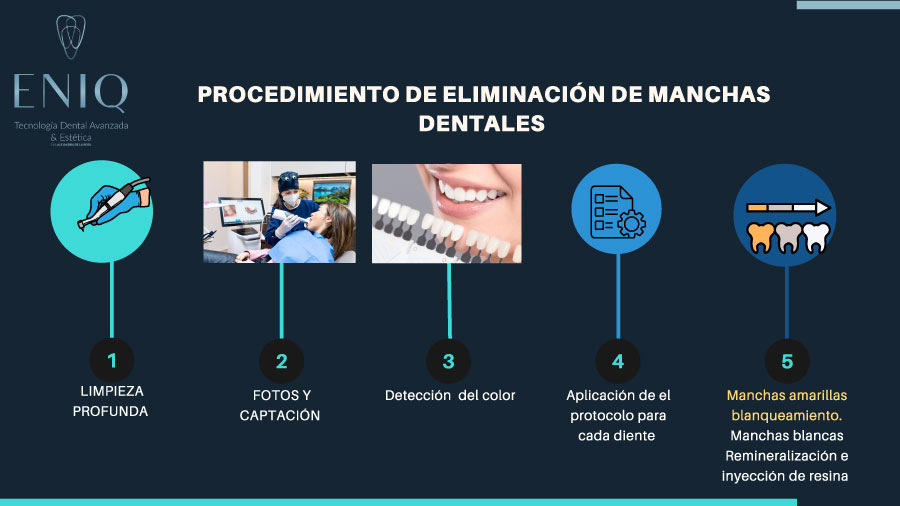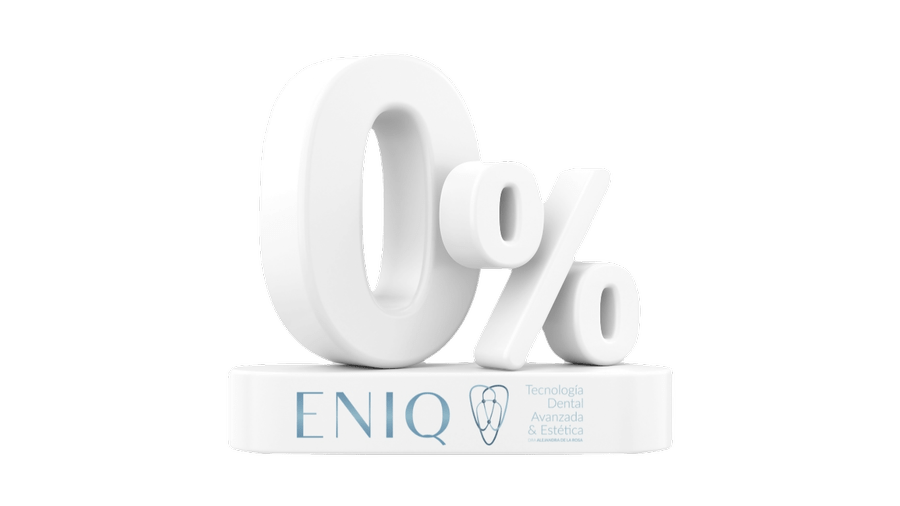

Tooth Stains
Remove tooth stains and restore the brightness of your smile at ENIQ.
What are Tooth Stains?
Tooth stains are color changes on the surface of the teeth that can vary in appearance and severity. They can appear as brown, yellow, black, white, or other abnormal shades on the teeth. Tooth stains can be caused by a variety of factors, including:
- Extrinsic pigmentation: occurs when color particles are deposited on the external surface of dental enamel. This can be caused by consuming certain foods and beverages like coffee, tea, red wine, foods with artificial colorings, as well as the habit of smoking or chewing tobacco.
- Intrinsic pigmentation: refers to stains that originate from within the tooth. It can be caused by genetic factors, exposure to certain medications during dental development, trauma or injuries to the teeth, excessive fluoride during tooth formation, or dental infections.
- Bacterial plaque and tartar: the buildup of bacterial plaque on the teeth can cause stains and discolorations. If plaque is not properly removed, it can harden and turn into tartar, which can also contribute to the appearance of stains.
It's important to note that tooth stains can vary in severity, and in some cases, they can be superficial and easily removed with a professional dental cleaning. However, in other cases, they may require more intensive treatments such as teeth whitening, veneers, or restorative procedures, depending on the cause and extent of the stains. It's advisable to consult a dentist to evaluate tooth stains and determine the best treatment approach in each case.
What Types of Tooth Stains Exist?
Tooth stains are color changes on the surface of the teeth that can vary in appearance and severity. They can appear as brown, yellow, black, white, or other abnormal shades on the teeth. Tooth stains can be caused by a variety of factors, including:
- Extrinsic pigmentation: occurs when color particles are deposited on the external surface of dental enamel. This can be caused by consuming certain foods and beverages like coffee, tea, red wine, foods with artificial colorings, as well as the habit of smoking or chewing tobacco.
- Intrinsic pigmentation: refers to stains that originate from within the tooth. It can be caused by genetic factors, exposure to certain medications during dental development, trauma or injuries to the teeth, excessive fluoride during tooth formation, or dental infections.
- Bacterial plaque and tartar: the buildup of bacterial plaque on the teeth can cause stains and discolorations. If plaque is not properly removed, it can harden and turn into tartar, which can also contribute to the appearance of stains.
It's important to note that tooth stains can vary in severity, and in some cases, they can be superficial and easily removed with a professional dental cleaning. However, in other cases, they may require more intensive treatments such as teeth whitening, veneers, or restorative procedures, depending on the cause and extent of the stains. It's advisable to consult a dentist to evaluate tooth stains and determine the best treatment approach in each case.

Procedure
What Is the Tooth Stain Removal Procedure?
The tooth stain removal procedure can vary depending on the type and severity of the stains. Here are some common methods used by dentists:

Required Appointments:
- Dental Cleaning: The removal of tooth stains typically begins with a professional dental cleaning or prophylaxis. During this procedure, the dentist or dental hygienist uses special tools such as an ultrasonic scaler or hand scalers to remove bacterial plaque, tartar, and surface stains from the teeth. This helps improve the appearance of the teeth and prevents dental problems.
- Teeth Whitening: Teeth whitening is a procedure used to remove or reduce extrinsic stains on the teeth and enhance their color. It can be performed in the dental office or by using whitening products at home under the dentist's supervision. Teeth whitening may involve the use of chemicals like hydrogen peroxide, which helps break down pigment molecules and lighten dental enamel.
- Dental Veneers: Dental veneers are thin layers of porcelain or composite resin that are bonded to the front surface of the teeth to enhance their appearance. Dental veneers can be used to cover persistent intrinsic stains or stains that do not respond to teeth whitening. This procedure is more invasive as it involves minimal enamel trimming before placing the veneers.
- Dental Restorations: In some cases, if tooth stains result from cavities or other dental conditions, it may be necessary to perform dental restorations such as fillings or crowns to remove the stains and repair damaged teeth.
It's important to note that the specific treatment for tooth stain removal will depend on the individual evaluation of each patient and the dentist's recommendations. It's advisable to consult a dental professional for an accurate diagnosis and to determine the best treatment approach for tooth stain removal.

What Causes Brown Stains on Teeth That Aren't Cavities?
Brown stains on teeth that aren't cavities can have various causes. Some possible explanations include:
- Food and Beverage Stains: Frequent consumption of pigmented foods and beverages such as coffee, tea, red wine, soy sauce, or foods with artificial colorings can lead to brown stains on the teeth. These stains are extrinsic in nature and occur due to the accumulation of pigments on the surface of dental enamel.
- Tobacco: Smoking cigarettes or chewing tobacco can cause brown stains on the teeth. Tar and chemical compounds present in tobacco can adhere to dental enamel and cause discoloration.
- Medication Stains: Some medications, such as tetracycline, administered during dental development can cause brown or gray stains on the teeth. These stains are intrinsic in nature and form when the medication incorporates into the tooth structure during development.
- Tooth Trauma or Injuries: A blow or injury to a tooth can lead to the appearance of brown stains. Trauma can damage the tooth pulp or cause internal bleeding, resulting in enamel discoloration.
- Fluorosis: Excess fluoride during tooth development, either from excessive fluoride consumption or exposure to high fluoride concentrations in drinking water, can cause brown stains on the teeth. Fluorosis is a condition that affects dental enamel and can lead to discoloration and changes in the appearance of the teeth.
If you have brown stains on your teeth and are unsure of their cause, it is recommended that you consult with a dentist. A dental professional can assess your teeth, determine the cause of the stains, and recommend the appropriate treatment to improve the appearance of your teeth.
What Are White Dental Spots in Children?
White dental spots in children are common and can have several causes. Some possible explanations include:
- Enamel Hypoplasia: Enamel hypoplasia is a condition in which dental enamel does not form properly. It can manifest as white spots on the teeth. This condition can be caused by various factors, such as nutritional deficiencies, developmental dental diseases, exposure to certain medications, or infections.
- Incipient Cavities: White spots on children's teeth can also be an early sign of incipient cavities or enamel demineralization. These spots result from the loss of minerals from dental enamel due to the action of acids produced by bacteria in dental plaque. If left untreated, demineralization can progress and become a dental cavity.
- Excessive Fluoride: Excessive fluoride consumption during tooth development can cause white spots on the teeth, a condition known as dental fluorosis. Fluoride is beneficial for dental health, but excessive exposure can alter the appearance of dental enamel, including the appearance of white spots.
- Calcium Deposits: Calcium deposits, also known as salivary calculi or sialoliths, are calcium deposits that form in the salivary glands. Sometimes, these deposits can cause white spots on the tooth surface.
It is important to note that the presence of white dental spots in children should be evaluated by a dentist. A dental professional can provide an accurate diagnosis and determine the cause of the spots. Depending on the situation, the dentist may recommend preventive measures, such as improving oral hygiene, adjusting fluoride intake, or applying specific treatments to prevent spot progression or treat incipient cavities.
How Are White Dental Spots Treated in Children and Adults?
The treatment of white dental spots in children and adults can vary depending on the cause and severity of the spots. Here are some common treatment options:
- Remineralization: If white spots result from enamel demineralization, the dentist may recommend treatments to help remineralize the teeth. These treatments may include the topical application of high-fluoride products or specific remineralizers to strengthen dental enamel and reduce spots. We use highly advanced techniques that can eliminate 90% to 100% of the white spot without reducing the dental structure; always adding to it.
- Teeth Whitening: In some cases, teeth whitening may be an option to treat white spots. Teeth whitening can help even out the tooth color, blur spots, and improve their appearance. However, it's important to carefully assess if whitening is suitable for each case, as there may be contraindications depending on the underlying cause of the spots.
- Enamel Microabrasion: Enamel microabrasion is a procedure in which a thin layer of dental enamel is removed by applying a mild acidic solution combined with gentle abrasion. This can help eliminate superficial stains and improve the appearance of teeth. However, this treatment may not be suitable for deeper or extensive stains.
- Dental Veneers: In more severe or persistent cases of white spots, dental veneers may be an option. Veneers are thin layers of porcelain or composite resin that are bonded to the front surface of the teeth to enhance their appearance. Veneers can cover spots and provide a natural aesthetic look.
It's important to note that the specific treatment will depend on the dentist's diagnosis and recommendations after evaluating dental stains. Each case is unique and may require a personalized approach. It is advisable to consult a dentist for an accurate diagnosis and to determine the best treatment plan for treating white dental spots in children and adults.
+90%
What is the success rate of the treatment for removing dental stains?
The success rate of dental stain removal treatments can vary depending on several factors, such as the cause of the stains, the severity of the stains, an individual's response to the treatment, and the technique used.
In general, treatments for removing dental stains often yield good results, especially when an accurate diagnosis is made and the recommendations of the dentist are followed. Some treatments, like professional dental cleaning, can effectively remove extrinsic stains and enhance the appearance of teeth in most cases.
However, it's important to note that the treatment's success may vary based on the cause of the stains and their depth. In some cases, such as more pronounced intrinsic stains or severe dental fluorosis, it may be more challenging to completely remove the stains and fully restore the natural color of the teeth.
It's essential to follow the guidance of the dentist, maintain good oral hygiene, and adopt proper dental care habits to optimize treatment results and keep your teeth clean and healthy.
For an accurate assessment of the success rate of treatment in a specific case, it's advisable to consult a dentist. A dental professional can evaluate dental stains, determine the underlying cause, and provide a more precise estimation of treatment success based on your individual dental situation.
What are the benefits of undergoing an anti-dental stains treatment at ENIQ?
Anti-dental stains treatment with technology can offer several benefits compared to traditional methods. Some of the benefits include:
- Precision: The technology used in dental stain removal treatments allows for greater precision in the process. High-tech equipment and devices can specifically target the stains and minimize the impact on the surrounding healthy dental tissue.
- Quick Results: Some technology-based treatments can provide faster results compared to conventional methods. For example, the use of lasers or advanced teeth whitening systems can expedite the stain removal process and achieve visible results in less time.
- Less Discomfort: Modern technology in dental treatments tends to be less invasive and, therefore, can reduce discomfort for the patient. For instance, LED or laser dental whitening systems may be less uncomfortable and cause less dental sensitivity compared to other methods.
- Customization: Technology allows for greater customization of dental treatments. Dentists can use advanced tools and devices to assess dental stains, identify their underlying cause, and tailor the treatment more precisely to the individual needs of each patient.
- Aesthetic Improvement: Technology-based treatment can provide enhanced and more satisfying aesthetic results. By using advanced devices and techniques, it is possible to more efficiently remove stains and achieve a whiter and more uniform dental appearance.
It is important to note that the benefits of technology-based treatments may vary depending on the type of technology used and the specific dental situation of each patient. Consulting with a dentist experienced in the use of advanced dental technology can help you better understand the specific benefits these treatments offer and determine which option is most suitable for you.
What is the price of the treatment for removing dental stains?
The price of teeth stain removal treatment can vary depending on several factors, such as the cause of the stains, the severity of the stains, the type of treatment used, the geographic location, and the experience of the dentist.
In general, simpler treatments like professional dental cleaning tend to be less expensive compared to more advanced treatments like teeth whitening or dental veneer placement.
The average price for dental remineralization for white stains is 50€ per session, depending on the number of white stains that can be treated in the same session, which could range from 50€ to 350€.
The average price for brown stains, which will be treated with whitening, will depend on the darkness of the stain and whether it requires external or internal and external whitening and can range from 150€ to 400€, depending on the number of affected teeth.
It's important to note that the cost of the treatment may include different aspects, such as dental consultations, specific procedures, materials used, and necessary follow-ups. Therefore, it's recommended to consult directly with a dental clinic to get accurate information about the prices of teeth stain removal treatment.
When planning a dental treatment, it's advisable to consider the quality and reputation of the dentist and the clinic, in addition to the price.
Please remember that the information provided here is general, and prices can vary considerably. It's best to get a personalized assessment from a dentist to get a more accurate idea of the cost of teeth stain removal treatment in your specific situation.

- Financing: Up to 24 months with no interest. Up to 60 months with preferential conditions.
- Payment Installment: Pay for the treatment in convenient monthly installments.
- Early Payment Discount: Pay for the entire treatment upfront and receive a discount.
- Multiple Payment Options: Direct debit, credit card, cash, bank transfer, Apple Pay, Google Pay, and Bizum.
Dental Stains
Perfect Smile
*subject to specialist evaluation
Experience a brighter and more radiant smile with our advanced teeth whitening treatment. This highly effective procedure is designed to remove stains and discoloration, restoring your teeth to their natural whiteness and significantly improving the aesthetics of your smile.
-
All-Inclusive
-
Interest-Free Financing
Frequently Asked Questions
Do you have more questions about dental stains?
Yes, over time, teeth can acquire some degree of discoloration due to enamel wear and other factors. Maintaining good oral care habits can delay this process.
Yes, smoking can cause brown stains on the teeth due to the chemical compounds present. Quitting smoking can help prevent and reduce these stains.
The complete removal of dental stains depends on the cause and severity. Some stains can be successfully treated, while others may require more intensive approaches to improve dental aesthetics.
